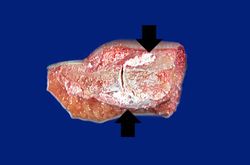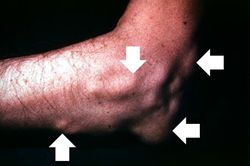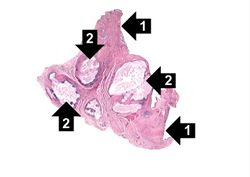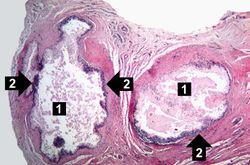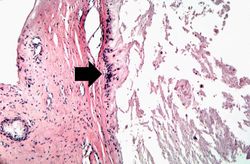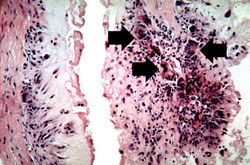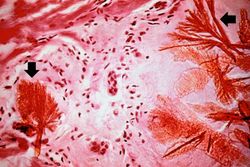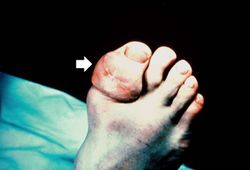Difference between revisions of "IPLab:Lab 5:Gout"
Seung Park (talk | contribs) |
Seung Park (talk | contribs) |
||
| Line 16: | Line 16: | ||
File:IPLab5Gout8.jpg|This is a gross photograph of a tophus on the great toe of another patient with gout (arrow). The healed surgical incision and the size of this tophus indicate that this was a long-standing problem for this patient. | File:IPLab5Gout8.jpg|This is a gross photograph of a tophus on the great toe of another patient with gout (arrow). The healed surgical incision and the size of this tophus indicate that this was a long-standing problem for this patient. | ||
</gallery> | </gallery> | ||
| + | |||
| + | == Study Questions == | ||
| + | * <spoiler text="What are the two types of gout and which is more common?">The main type is primary gout which makes up 90% of all cases. In most cases of primary gout the enzyme defect is unknown. In rare cases the enzyme defect is known, but gout symptomatology is the main clinical finding. | ||
| + | |||
| + | In secondary gout the cause of the hyperuricemia is known (e.g. leukemia, renal failure, Lesch-Nyhan syndrome).</spoiler> | ||
| + | * <spoiler text="What are the four stages of gout?"># Asymptomatic hyperuricemia | ||
| + | # Acute gouty arthritis | ||
| + | # Intercritical gout | ||
| + | # Chronic tophaceous gout.</spoiler> | ||
| + | * <spoiler text="Why is gout more severe in peripheral joints?">The decreased temperature accentuates the crystallization of monosodium urate (MSU).</spoiler> | ||
| + | * <spoiler text="What initiates the inflammatory reaction seen in the synovial membrane in gouty arthritis?">MSU crystals are chemotactic and they activate complement. This initiates a cascade of inflammatory events which leads to acute gouty arthritis.</spoiler> | ||
{{IPLab 5}} | {{IPLab 5}} | ||
[[Category: IPLab:Lab 5]] | [[Category: IPLab:Lab 5]] | ||
Revision as of 15:15, 21 August 2013
Clinical Summary[edit]
This patient was diagnosed with gout approximately 20 years ago. At that time, he noted the gradual onset of pain in the left knee, followed by swelling, redness and heat, all of which persisted for approximately one month. Shortly thereafter, he had periodic episodes of hot, painful, swollen joints involving the left knee, left ankle, and both first metatarsophalangeal joints. At this time the patient was hospitalized for evaluation of these arthritides. Serum uric acid values on three separate occasions were 8.0, 9.3, and 8.7 mg/dl. In addition to the presence of the painful swollen joints, a gouty tophus was present on the left arm. The patient was readmitted to the hospital from time to time because of acute exacerbations of gouty arthritis. On the most recent hospital admission, a 3-cm tophus was found over the right elbow, as well as several smaller tophi over the right hand.
Autopsy Findings[edit]
The specimen consisted of an elliptically shaped, mottled, yellow-white irregular hard mass, measuring 8.0 x 5.0 x 2.0 cm. in diameter.
Images[edit]
This is a photomicrograph of a tophus that was fixed in alcohol prior to histologic processing. The alcohol fixation preserves the water soluble urate crystals within the tissue. Note the urate crystals visible in this photomicrograph (arrows). Also note the chronic inflammatory reaction in the background.
Study Questions[edit]
| |||||
The normal serum uric acid level for a male is 3.9 to 8.1 mg/dl.
A tophus is a chalky accumulation of urate crystals found in the tissue surrounding a joint.
The normal fibrinogen level is 184 to 412 mg/dL.
Renal failure is the severe reduction of renal function and often leads to reduced urinary output.
